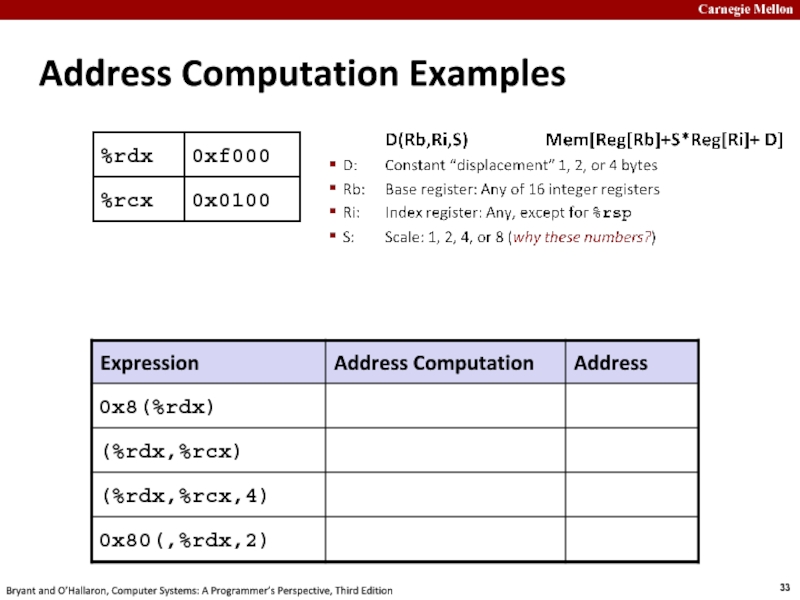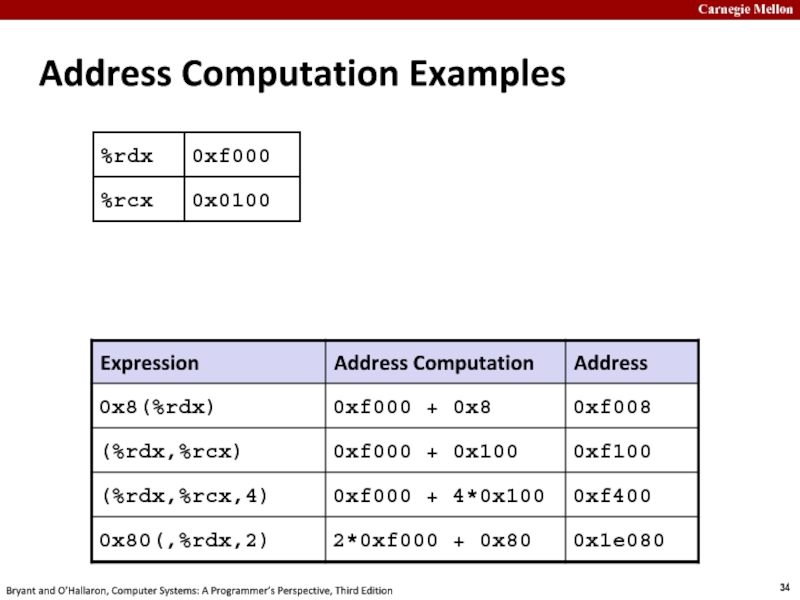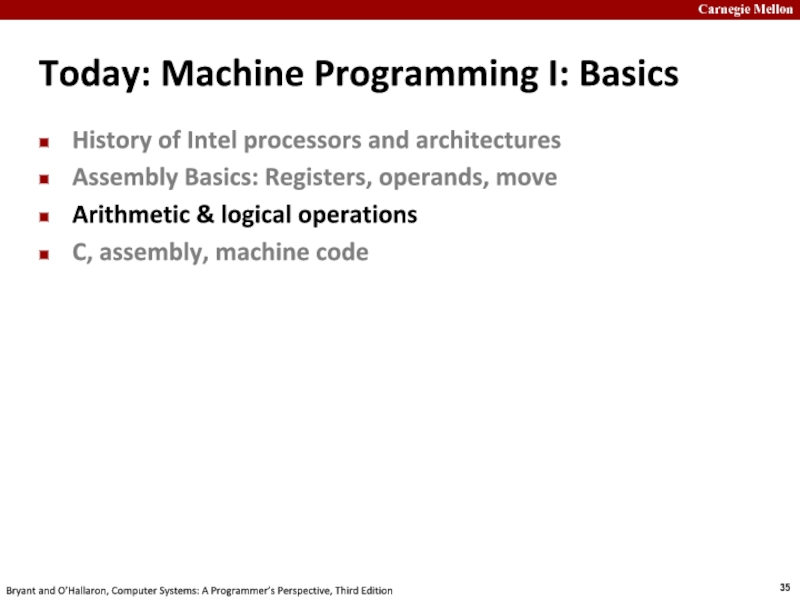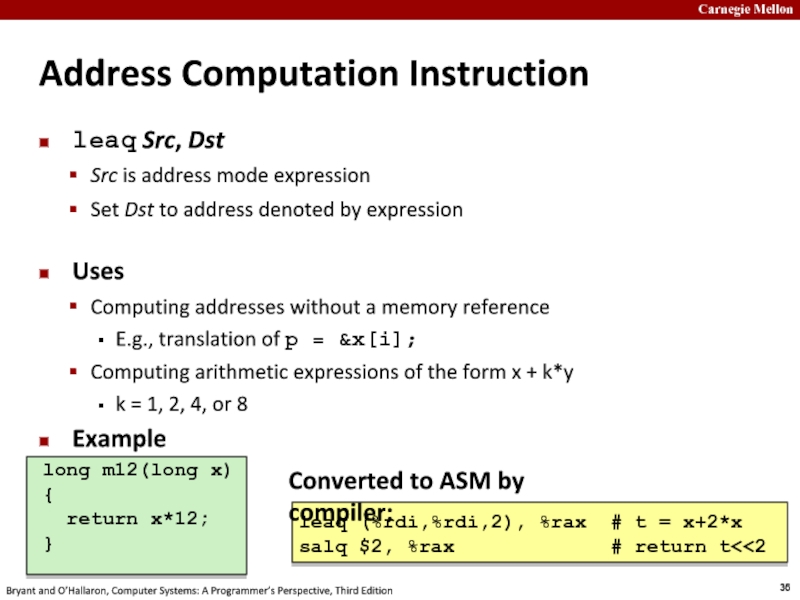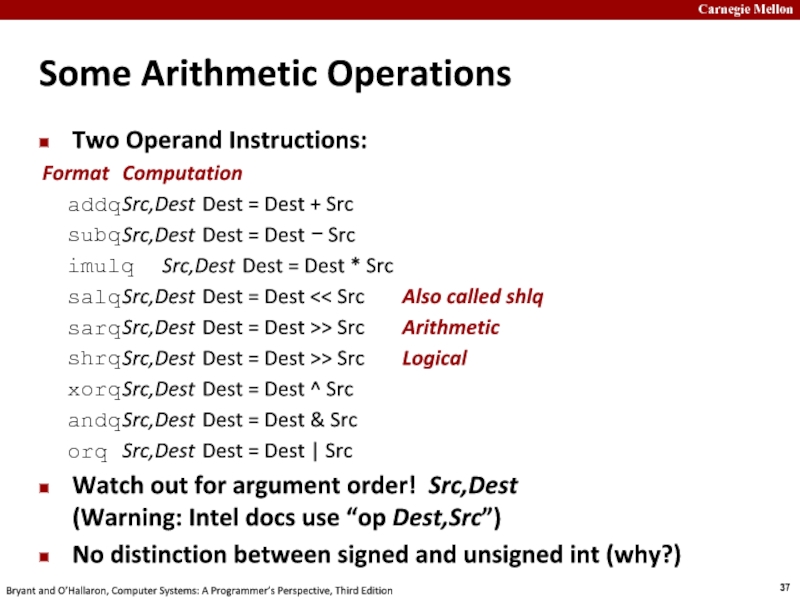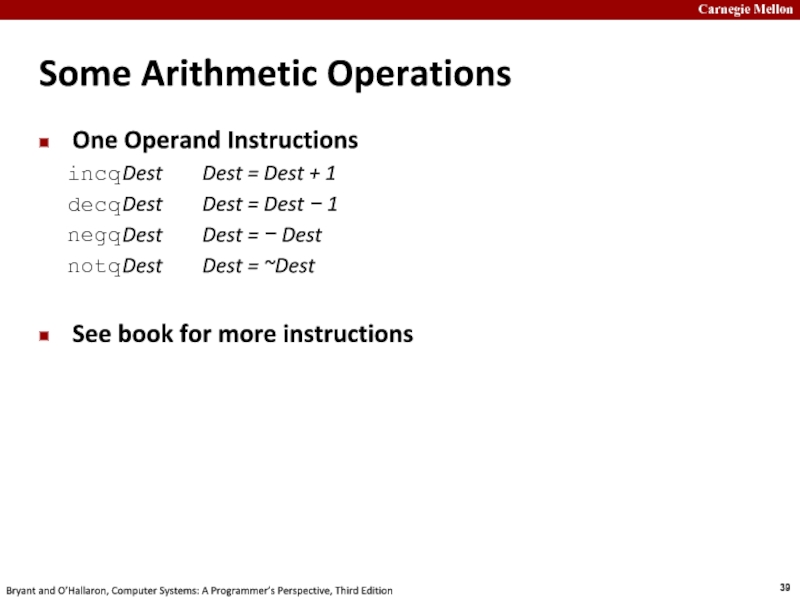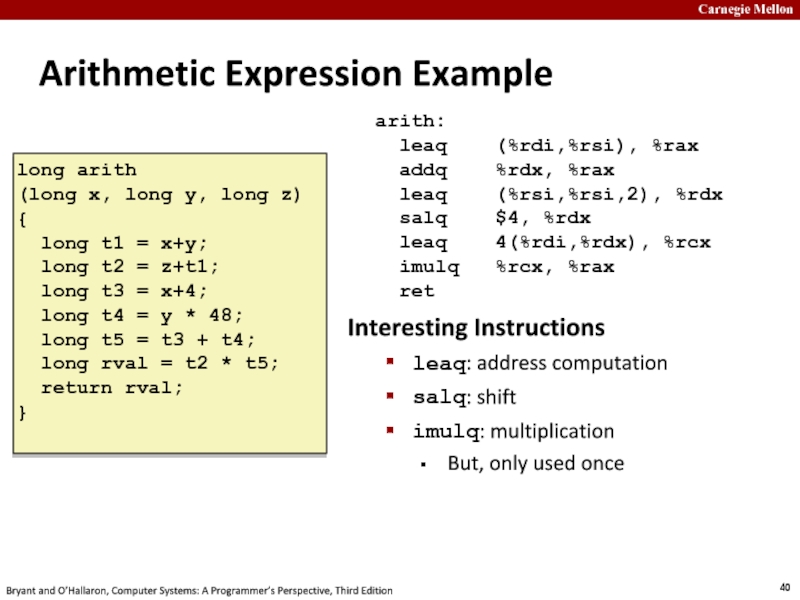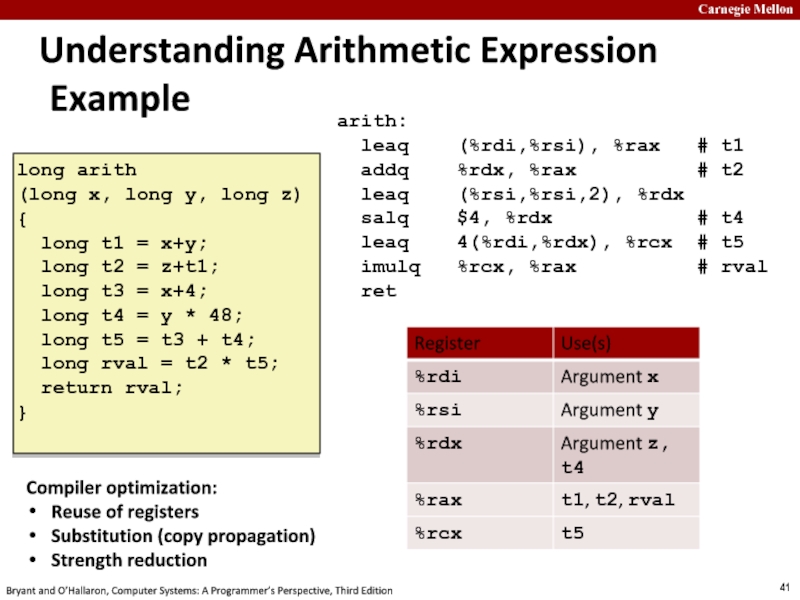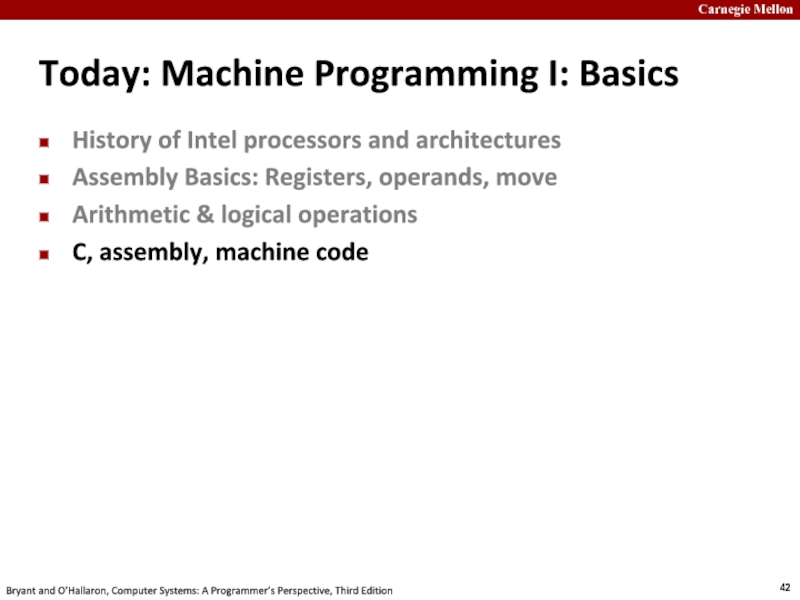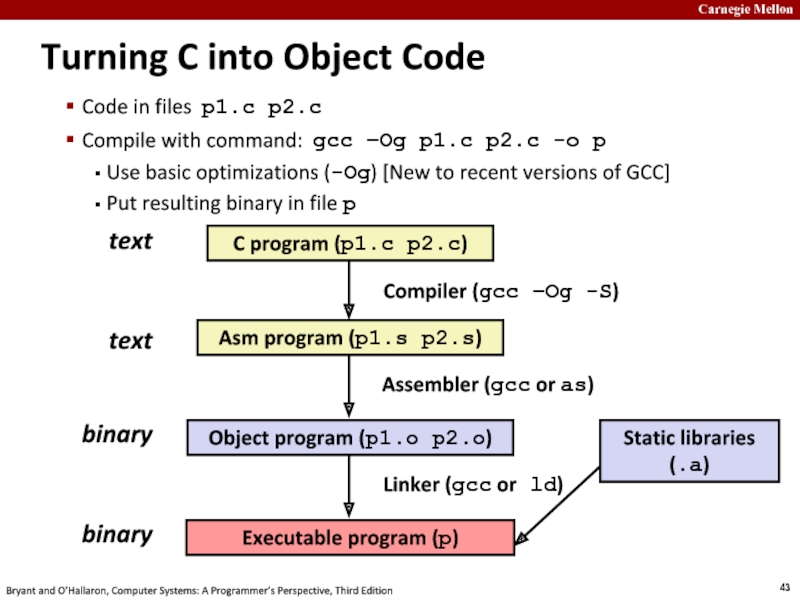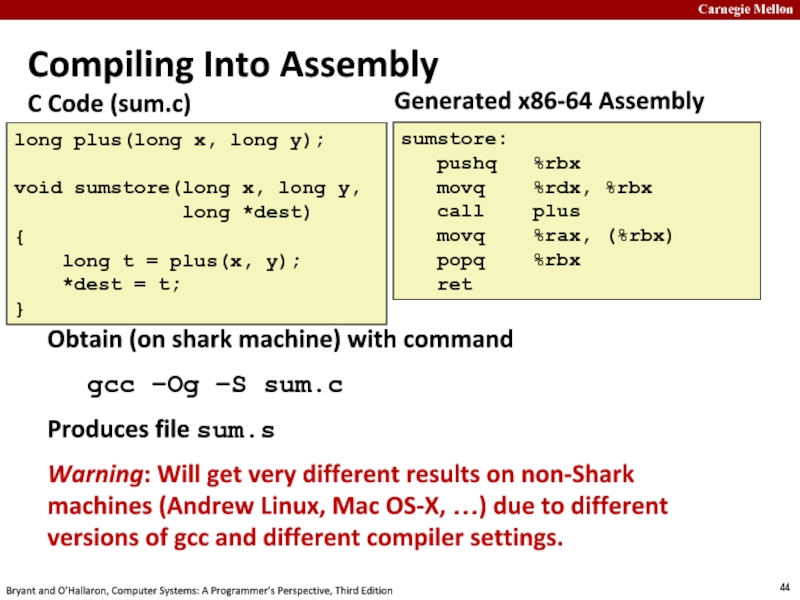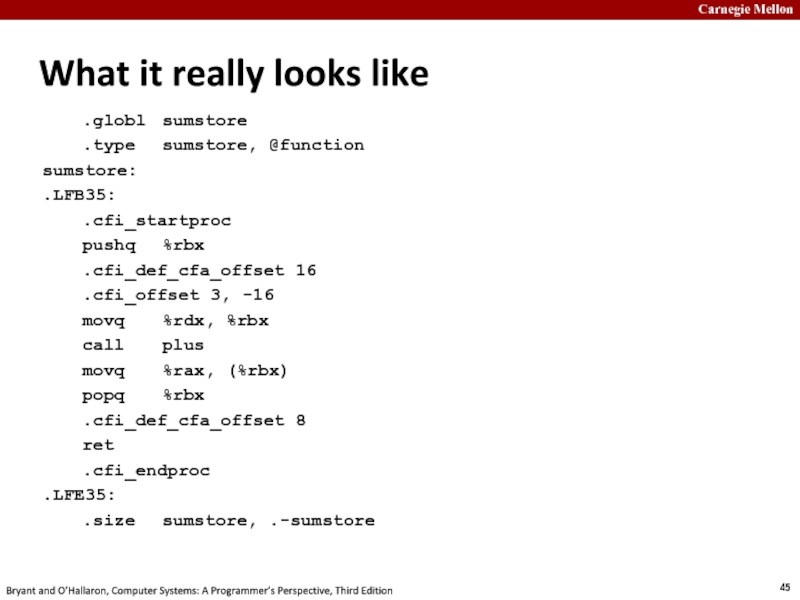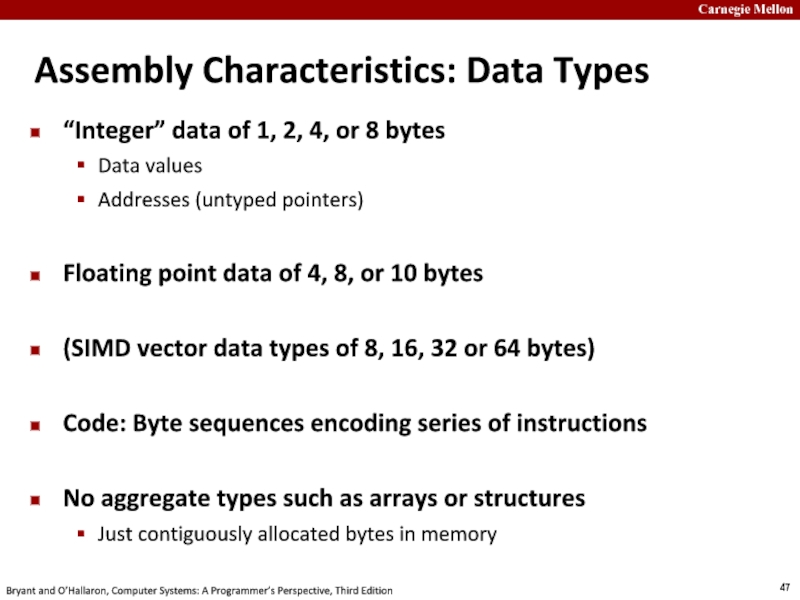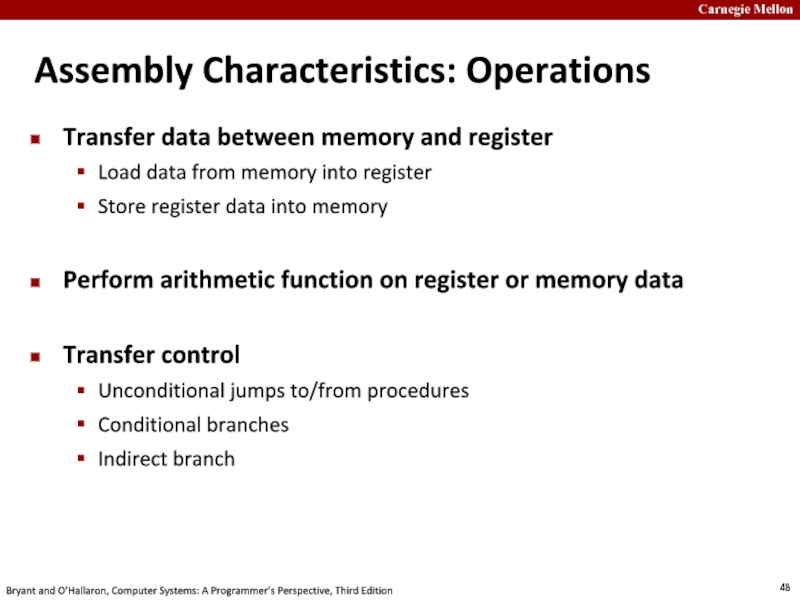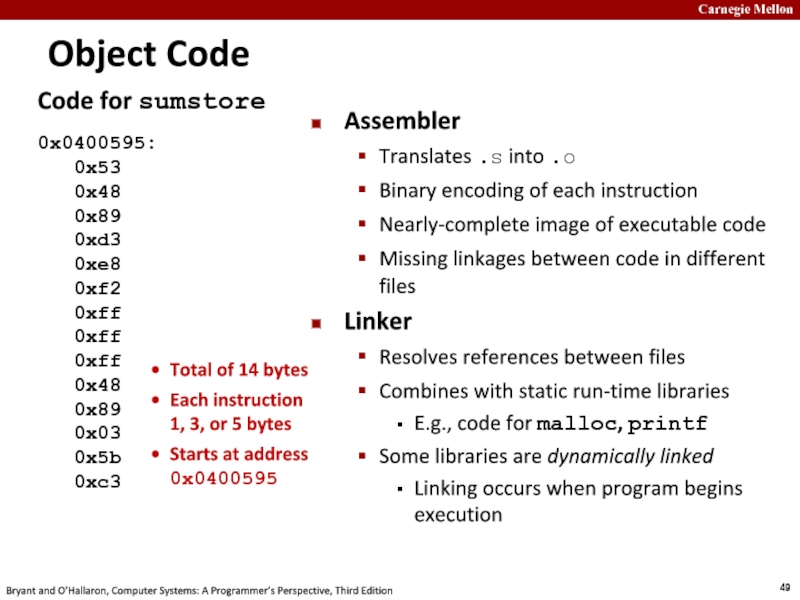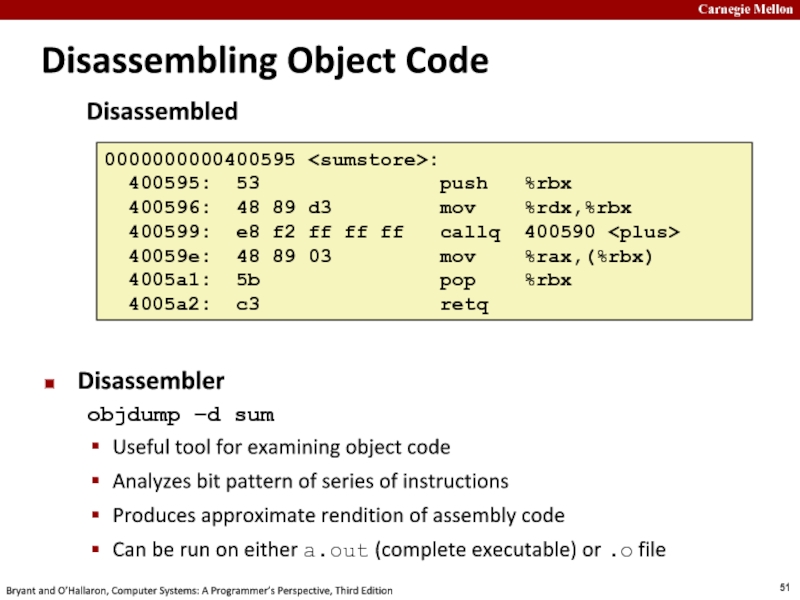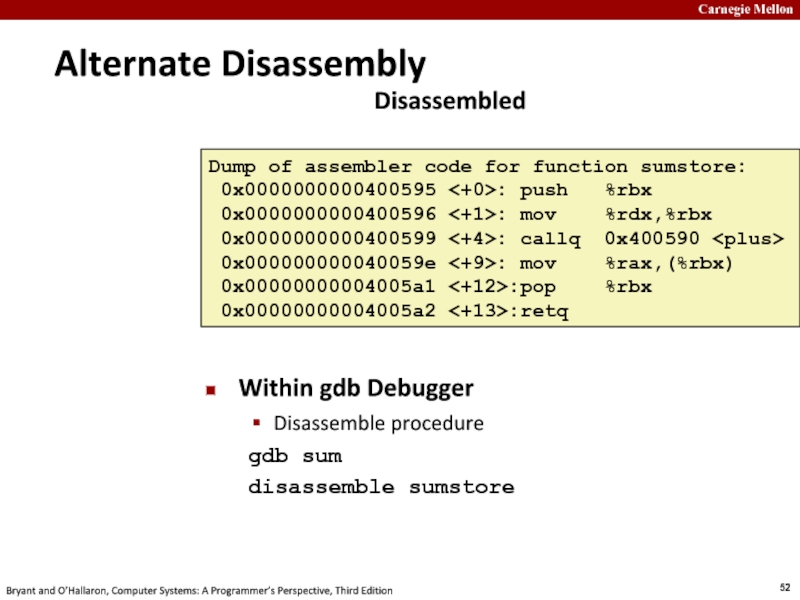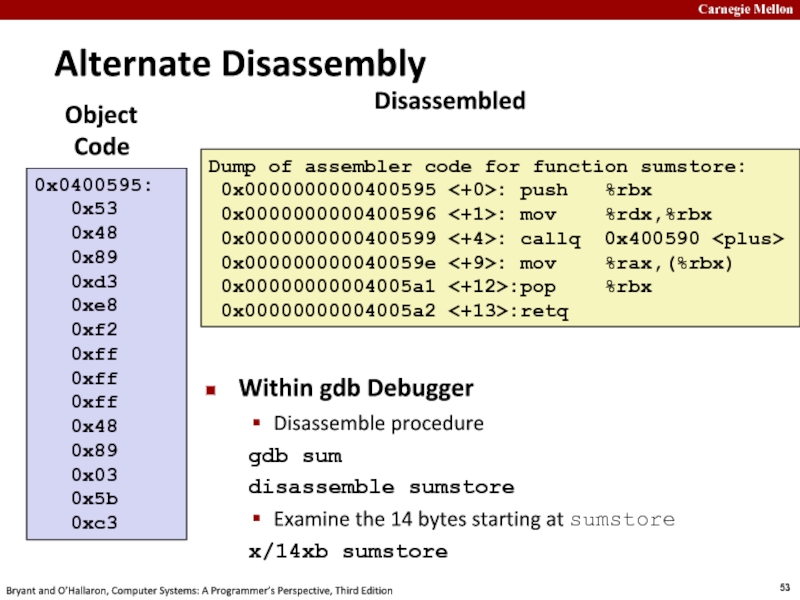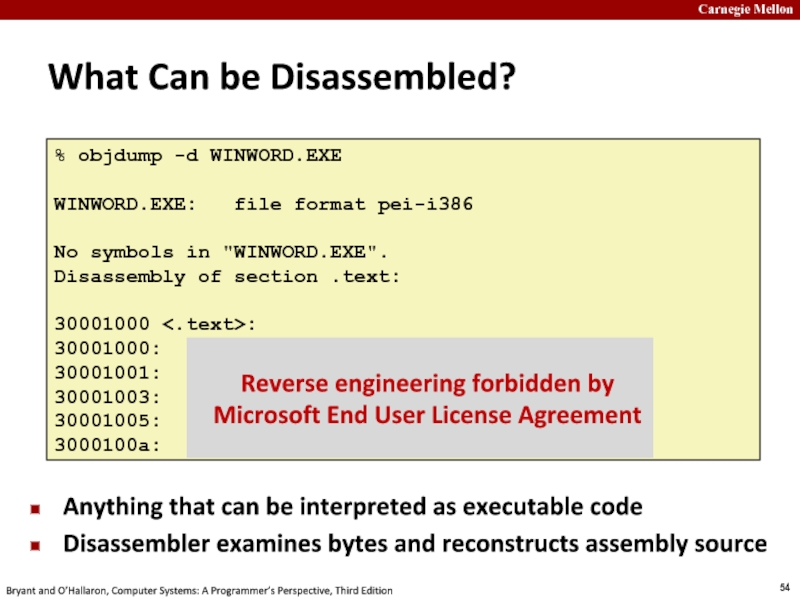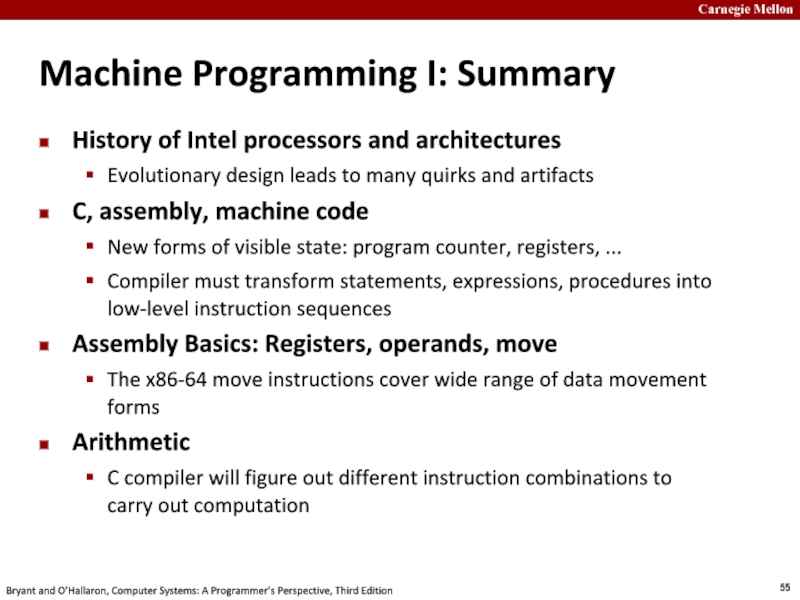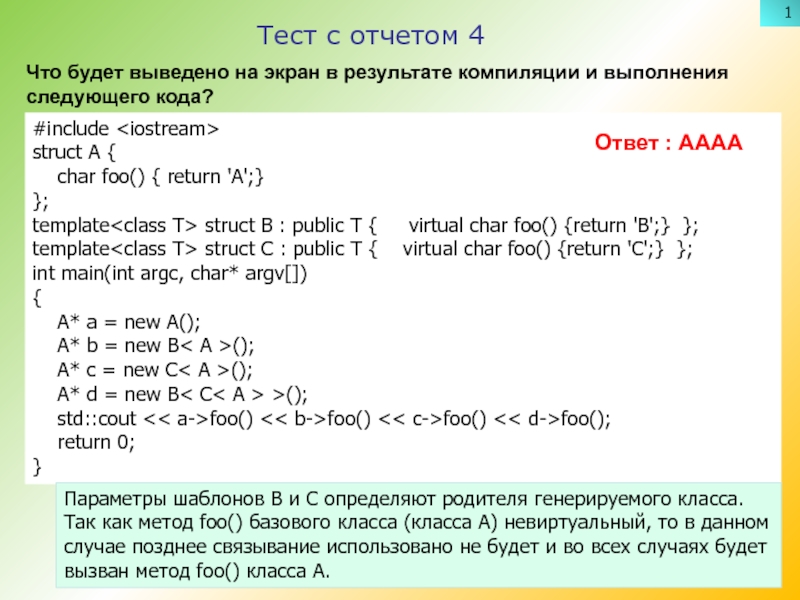Разделы презентаций
- Разное
- Английский язык
- Астрономия
- Алгебра
- Биология
- География
- Геометрия
- Детские презентации
- Информатика
- История
- Литература
- Математика
- Медицина
- Менеджмент
- Музыка
- МХК
- Немецкий язык
- ОБЖ
- Обществознание
- Окружающий мир
- Педагогика
- Русский язык
- Технология
- Физика
- Философия
- Химия
- Шаблоны, картинки для презентаций
- Экология
- Экономика
- Юриспруденция
Machine-Level Programming I: Basics 15-213/18-213 : Introduction to Computer
Содержание
- 1. Machine-Level Programming I: Basics 15-213/18-213 : Introduction to Computer
- 2. Office HoursNot too well attended (yet?)Ask your
- 3. Today: Machine Programming I: BasicsHistory of Intel
- 4. Intel x86 ProcessorsDominate laptop/desktop/server marketEvolutionary designBackwards compatible
- 5. Intel x86 Evolution: Milestones Name Date Transistors MHz8086 1978 29K 5-10First 16-bit Intel processor.
- 6. Intel x86 Processors, cont.Machine Evolution386 1985 0.3M Pentium 1993 3.1MPentium/MMX 1997 4.5MPentiumPro 1995 6.5MPentium III 1999 8.2MPentium 4 2000 42MCore
- 7. Intel x86 Processors, cont.Past Generations1st Pentium Pro 1995 600
- 8. 2018 State of the Art: Skylake (Core
- 9. x86 Clones: Advanced Micro Devices (AMD)HistoricallyAMD has
- 10. Intel’s 64-Bit History2001: Intel Attempts Radical Shift
- 11. Our CoverageIA32The traditional x86For 15/18-213: RIP, Summer
- 12. Today: Machine Programming I: BasicsHistory of Intel
- 13. Levels of AbstractionC programmerAssembly programmerComputer DesignerC codeCaches,
- 14. DefinitionsArchitecture: (also ISA: instruction set architecture) The
- 15. CPUAssembly/Machine Code ViewProgrammer-Visible StatePC: Program counterAddress of
- 16. Assembly Characteristics: Data Types“Integer” data of 1,
- 17. %rspx86-64 Integer RegistersCan reference low-order 4 bytes
- 18. Some History: IA32 Registers%ax%cx%dx%bx%si%di%sp%bp%ah%ch%dh%bh%al%cl%dl%bl16-bit virtual registers(backwards compatibility)general purposeaccumulatecounterdatabasesource indexdestinationindexstack pointerbasepointerOrigin(mostly obsolete)
- 19. Assembly Characteristics: OperationsTransfer data between memory and
- 20. Moving DataMoving Datamovq Source, DestOperand TypesImmediate: Constant
- 21. movq Operand CombinationsCannot do memory-memory transfer with
- 22. Simple Memory Addressing ModesNormal (R) Mem[Reg[R]]Register R specifies memory
- 23. Example of Simple Addressing ModeswhatAmI: movq
- 24. Example of Simple Addressing Modesvoid swap
- 25. Understanding Swap()void swap (long *xp, long
- 26. Understanding Swap()123456RegistersMemoryswap: movq (%rdi), %rax
- 27. Understanding Swap()123456RegistersMemoryswap: movq (%rdi), %rax
- 28. Understanding Swap()123456RegistersMemoryswap: movq (%rdi), %rax
- 29. Understanding Swap()456456RegistersMemoryswap: movq (%rdi), %rax
- 30. Understanding Swap()456123RegistersMemoryswap: movq (%rdi), %rax
- 31. Simple Memory Addressing ModesNormal (R) Mem[Reg[R]]Register R specifies memory
- 32. Complete Memory Addressing ModesMost General Form D(Rb,Ri,S) Mem[Reg[Rb]+S*Reg[Ri]+ D]D:
- 33. Address Computation Examples
- 34. Address Computation Examples
- 35. Today: Machine Programming I: BasicsHistory of Intel
- 36. Address Computation Instructionleaq Src, DstSrc is address
- 37. Some Arithmetic OperationsTwo Operand Instructions:Format Computationaddq Src,Dest Dest = Dest
- 38. Quiz Time! halblustig: German, literal translation: “semi-funny”
- 39. Some Arithmetic OperationsOne Operand Instructionsincq Dest Dest = Dest
- 40. Arithmetic Expression ExampleInteresting Instructionsleaq: address computationsalq: shiftimulq:
- 41. Understanding Arithmetic Expression Examplelong arith(long x, long
- 42. Today: Machine Programming I: BasicsHistory of Intel
- 43. texttextbinarybinaryCompiler (gcc –Og -S)Assembler (gcc or as)Linker
- 44. Compiling Into AssemblyC Code (sum.c)long plus(long x,
- 45. What it really looks like .globl sumstore .type sumstore, @functionsumstore:.LFB35: .cfi_startproc pushq %rbx .cfi_def_cfa_offset 16 .cfi_offset 3, -16 movq %rdx, %rbx call plus movq %rax, (%rbx) popq %rbx .cfi_def_cfa_offset 8 ret .cfi_endproc.LFE35: .size sumstore, .-sumstore
- 46. What it really looks like .globl sumstore .type sumstore, @functionsumstore:.LFB35: .cfi_startproc pushq %rbx .cfi_def_cfa_offset 16 .cfi_offset
- 47. Assembly Characteristics: Data Types“Integer” data of 1,
- 48. Assembly Characteristics: OperationsTransfer data between memory and
- 49. Code for sumstore0x0400595: 0x53 0x48
- 50. Machine Instruction ExampleC CodeStore value t where
- 51. DisassembledDisassembling Object CodeDisassemblerobjdump –d sumUseful tool for
- 52. Alternate DisassemblyWithin gdb DebuggerDisassemble proceduregdb sumdisassemble sumstore
- 53. Alternate DisassemblyWithin gdb DebuggerDisassemble proceduregdb sumdisassemble sumstoreExamine the 14 bytes starting at sumstorex/14xb sumstore
- 54. What Can be Disassembled?Anything that can be
- 55. Machine Programming I: SummaryHistory of Intel processors
- 56. Скачать презентанцию
Слайды и текст этой презентации
Слайд 1Machine-Level Programming I: Basics 15-213/18-213: Introduction to Computer Systems 5th Lecture,
January 30, 2018
Слайд 2Office Hours
Not too well attended (yet?)
Ask your TAs about how
it was last
year…
You can choose from coffee, tea,
and
hot chocolateHere’s where my office is: HH A312
The time: Tues. 4pm-5pm
https://users.ece.cmu.edu/~franzf/officelocation.htm
Слайд 3Today: Machine Programming I: Basics
History of Intel processors and architectures
Assembly
Basics: Registers, operands, move
Arithmetic & logical operations
C, assembly, machine code
Слайд 4Intel x86 Processors
Dominate laptop/desktop/server market
Evolutionary design
Backwards compatible up until 8086,
introduced in 1978
Added more features as time goes on
Now 3
volumes, about 5,000 pages of documentationComplex instruction set computer (CISC)
Many different instructions with many different formats
But, only small subset encountered with Linux programs
Hard to match performance of Reduced Instruction Set Computers (RISC)
But, Intel has done just that!
In terms of speed. Less so for low power.
Слайд 5Intel x86 Evolution: Milestones
Name Date Transistors MHz
8086 1978 29K 5-10
First 16-bit Intel processor. Basis for IBM
PC & DOS
1MB address space
386 1985 275K 16-33
First 32 bit Intel processor ,
referred to as IA32Added “flat addressing”, capable of running Unix
Pentium 4E 2004 125M 2800-3800
First 64-bit Intel x86 processor, referred to as x86-64
Core 2 2006 291M 1060-3333
First multi-core Intel processor
Core i7 2008 731M 1600-4400
Four cores (our shark machines)
Слайд 6Intel x86 Processors, cont.
Machine Evolution
386 1985 0.3M
Pentium 1993 3.1M
Pentium/MMX 1997 4.5M
PentiumPro 1995 6.5M
Pentium III 1999 8.2M
Pentium 4 2000 42M
Core 2 Duo 2006 291M
Core i7 2008 731M
Core
i7 Skylake 2015 1.9B
Added Features
Instructions to support multimedia operations
Instructions to enable more
efficient conditional operationsTransition from 32 bits to 64 bits
More cores
Слайд 7Intel x86 Processors, cont.
Past Generations
1st Pentium Pro 1995 600 nm
1st Pentium III 1999 250
nm
1st Pentium 4 2000 180 nm
1st Core 2 Duo 2006 65 nm
Recent Generations
Nehalem 2008
45 nm Sandy Bridge 2011 32 nm
Ivy Bridge 2012 22 nm
Haswell 2013 22 nm
Broadwell 2014 14 nm
Skylake 2015 14 nm
Kaby Lake 2016 14 nm
Coffee Lake 2017? 14 nm
Cannonlake 2018? 10 nm
Process technology
Process technology dimension
= width of narrowest wires
(10 nm ≈ 100 atoms wide)
Слайд 82018 State of the Art: Skylake (Core i7 v6)
Mobile Model:
Core i7
2.6-2.9 GHz
45 W
Desktop Model: Core i7
Integrated graphics
2.8-4.0 GHz
35-91 W
Server
Model: XeonIntegrated graphics
Multi-socket enabled
2-3.7 GHz
25-80 W
Слайд 9x86 Clones: Advanced Micro Devices (AMD)
Historically
AMD has followed just behind
Intel
A little bit slower, a lot cheaper
Then
Recruited top circuit designers
from Digital Equipment Corp. and other downward trending companiesBuilt Opteron: tough competitor to Pentium 4
Developed x86-64, their own extension to 64 bits
Recent Years
Intel got its act together
Leads the world in semiconductor technology
AMD has fallen behind
Relies on external semiconductor manufacturer
Слайд 10Intel’s 64-Bit History
2001: Intel Attempts Radical Shift from IA32 to
IA64
Totally different architecture (Itanium)
Executes IA32 code only as legacy
Performance disappointing
2003:
AMD Steps in with Evolutionary Solutionx86-64 (now called “AMD64”)
Intel Felt Obligated to Focus on IA64
Hard to admit mistake or that AMD is better
2004: Intel Announces EM64T extension to IA32
Extended Memory 64-bit Technology
Almost identical to x86-64!
All but low-end x86 processors support x86-64
But, lots of code still runs in 32-bit mode
Слайд 11Our Coverage
IA32
The traditional x86
For 15/18-213: RIP, Summer 2015
x86-64
The standard
shark> gcc
hello.c
shark> gcc –m64 hello.c
Presentation
Book covers x86-64
Web aside on IA32
We will
only cover x86-64Слайд 12Today: Machine Programming I: Basics
History of Intel processors and architectures
Assembly
Basics: Registers, operands, move
Arithmetic & logical operations
C, assembly, machine code
Слайд 13Levels of Abstraction
C programmer
Assembly programmer
Computer Designer
C code
Caches, clock freq, layout,
…
Nice clean layers,
but beware…
Of course, you know that:
It’s why you are taking this course.Слайд 14Definitions
Architecture: (also ISA: instruction set architecture) The parts of a
processor design that one needs to understand for writing assembly/machine
code.Examples: instruction set specification, registers
Microarchitecture: Implementation of the architecture
Examples: cache sizes and core frequency
Code Forms:
Machine Code: The byte-level programs that a processor executes
Assembly Code: A text representation of machine code
Example ISAs:
Intel: x86, IA32, Itanium, x86-64
ARM: Used in almost all mobile phones
RISC V: New open-source ISA
Слайд 15CPU
Assembly/Machine Code View
Programmer-Visible State
PC: Program counter
Address of next instruction
Called “RIP”
(x86-64)
Register file
Heavily used program data
Condition codes
Store status information about most
recent arithmetic or logical operationUsed for conditional branching
PC
Registers
Memory
Code
Data
Stack
Addresses
Data
Instructions
Condition
Codes
Memory
Byte addressable array
Code and user data
Stack to support procedures
Слайд 16Assembly Characteristics: Data Types
“Integer” data of 1, 2, 4, or
8 bytes
Data values
Addresses (untyped pointers)
Floating point data of 4, 8,
or 10 bytes(SIMD vector data types of 8, 16, 32 or 64 bytes)
Code: Byte sequences encoding series of instructions
No aggregate types such as arrays or structures
Just contiguously allocated bytes in memory
Слайд 17%rsp
x86-64 Integer Registers
Can reference low-order 4 bytes (also low-order 1
& 2 bytes)
Not part of memory (or cache)
%eax
%ebx
%ecx
%edx
%esi
%edi
%esp
%ebp
%r8d
%r9d
%r10d
%r11d
%r12d
%r13d
%r14d
%r15d
%r8
%r9
%r10
%r11
%r12
%r13
%r14
%r15
%rax
%rbx
%rcx
%rdx
%rsi
%rdi
%rbp
Слайд 18Some History: IA32 Registers
%ax
%cx
%dx
%bx
%si
%di
%sp
%bp
%ah
%ch
%dh
%bh
%al
%cl
%dl
%bl
16-bit virtual registers
(backwards compatibility)
general purpose
accumulate
counter
data
base
source
index
destination
index
stack
pointer
base
pointer
Origin
(mostly
obsolete)
Слайд 19Assembly Characteristics: Operations
Transfer data between memory and register
Load data from
memory into register
Store register data into memory
Perform arithmetic function on
register or memory dataTransfer control
Unconditional jumps to/from procedures
Conditional branches
Indirect branches
Слайд 20Moving Data
Moving Data
movq Source, Dest
Operand Types
Immediate: Constant integer data
Example: $0x400,
$-533
Like C constant, but prefixed with ‘$’
Encoded with 1, 2,
or 4 bytesRegister: One of 16 integer registers
Example: %rax, %r13
But %rsp reserved for special use
Others have special uses for particular instructions
Memory: 8 consecutive bytes of memory at address given by register
Simplest example: (%rax)
Various other “addressing modes”
Warning: Intel docs use
mov Dest, Source
Слайд 21movq Operand Combinations
Cannot do memory-memory transfer with a single instruction
movq
Imm
Reg
Mem
Reg
Mem
Reg
Mem
Reg
Source
Dest
C
Analog
movq $0x4,%rax
temp = 0x4;
movq $-147,(%rax)
*p = -147;
movq %rax,%rdx
temp2 = temp1;
movq
%rax,(%rdx)*p = temp;
movq (%rax),%rdx
temp = *p;
Src,Dest
Слайд 22Simple Memory Addressing Modes
Normal (R) Mem[Reg[R]]
Register R specifies memory address
Aha! Pointer dereferencing
in C
movq (%rcx),%rax
Displacement D(R) Mem[Reg[R]+D]
Register R specifies start of memory region
Constant displacement
D specifies offset
movq 8(%rbp),%rdxСлайд 23Example of Simple Addressing Modes
whatAmI:
movq (%rdi), %rax
movq (%rsi), %rdx
movq %rdx, (%rdi)
movq %rax, (%rsi)ret
void
whatAmI(
{
????
}
Слайд 24Example of Simple Addressing Modes
void swap
(long *xp, long
*yp)
{
long t0 = *xp;
long t1 = *yp;
*xp = t1;*yp = t0;
}
swap:
movq (%rdi), %rax
movq (%rsi), %rdx
movq %rdx, (%rdi)
movq %rax, (%rsi)
ret
Слайд 25Understanding Swap()
void swap
(long *xp, long *yp)
{
long
t0 = *xp;
long t1 = *yp;
*xp = t1;
*yp = t0;}
Memory
Register Value
%rdi xp
%rsi yp
%rax t0
%rdx t1
swap:
movq (%rdi), %rax # t0 = *xp
movq (%rsi), %rdx # t1 = *yp
movq %rdx, (%rdi) # *xp = t1
movq %rax, (%rsi) # *yp = t0
ret
Registers
Слайд 26Understanding Swap()
123
456
Registers
Memory
swap:
movq (%rdi), %rax # t0 =
*xp
movq (%rsi), %rdx # t1 =
*ypmovq %rdx, (%rdi) # *xp = t1
movq %rax, (%rsi) # *yp = t0
ret
Слайд 27Understanding Swap()
123
456
Registers
Memory
swap:
movq (%rdi), %rax # t0 =
*xp
movq (%rsi), %rdx # t1 =
*ypmovq %rdx, (%rdi) # *xp = t1
movq %rax, (%rsi) # *yp = t0
ret
Слайд 28Understanding Swap()
123
456
Registers
Memory
swap:
movq (%rdi), %rax # t0 =
*xp
movq (%rsi), %rdx # t1 =
*ypmovq %rdx, (%rdi) # *xp = t1
movq %rax, (%rsi) # *yp = t0
ret
Слайд 29Understanding Swap()
456
456
Registers
Memory
swap:
movq (%rdi), %rax # t0 =
*xp
movq (%rsi), %rdx # t1 =
*ypmovq %rdx, (%rdi) # *xp = t1
movq %rax, (%rsi) # *yp = t0
ret
Слайд 30Understanding Swap()
456
123
Registers
Memory
swap:
movq (%rdi), %rax # t0 =
*xp
movq (%rsi), %rdx # t1 =
*ypmovq %rdx, (%rdi) # *xp = t1
movq %rax, (%rsi) # *yp = t0
ret
Слайд 31Simple Memory Addressing Modes
Normal (R) Mem[Reg[R]]
Register R specifies memory address
Aha! Pointer dereferencing
in C
movq (%rcx),%rax
Displacement D(R) Mem[Reg[R]+D]
Register R specifies start of memory region
Constant displacement
D specifies offset
movq 8(%rbp),%rdxСлайд 32Complete Memory Addressing Modes
Most General Form
D(Rb,Ri,S) Mem[Reg[Rb]+S*Reg[Ri]+ D]
D: Constant “displacement” 1,
2, or 4 bytes
Rb: Base register: Any of 16 integer
registersRi: Index register: Any, except for %rsp
S: Scale: 1, 2, 4, or 8 (why these numbers?)
Special Cases
(Rb,Ri) Mem[Reg[Rb]+Reg[Ri]]
D(Rb,Ri) Mem[Reg[Rb]+Reg[Ri]+D]
(Rb,Ri,S) Mem[Reg[Rb]+S*Reg[Ri]]
Слайд 35Today: Machine Programming I: Basics
History of Intel processors and architectures
Assembly
Basics: Registers, operands, move
Arithmetic & logical operations
C, assembly, machine code
Слайд 36Address Computation Instruction
leaq Src, Dst
Src is address mode expression
Set Dst
to address denoted by expression
Uses
Computing addresses without a memory reference
E.g.,
translation of p = &x[i];Computing arithmetic expressions of the form x + k*y
k = 1, 2, 4, or 8
Example
long m12(long x)
{
return x*12;
}
leaq (%rdi,%rdi,2), %rax # t = x+2*x
salq $2, %rax # return t<<2
Converted to ASM by compiler:
Слайд 37Some Arithmetic Operations
Two Operand Instructions:
Format Computation
addq Src,Dest Dest = Dest + Src
subq Src,Dest Dest =
Dest Src
imulq Src,Dest Dest = Dest * Src
salq Src,Dest Dest = Dest
Src Also called shlqsarq Src,Dest Dest = Dest >> Src Arithmetic
shrq Src,Dest Dest = Dest >> Src Logical
xorq Src,Dest Dest = Dest ^ Src
andq Src,Dest Dest = Dest & Src
orq Src,Dest Dest = Dest | Src
Watch out for argument order! Src,Dest (Warning: Intel docs use “op Dest,Src”)
No distinction between signed and unsigned int (why?)
Слайд 38Quiz Time! halblustig: German, literal translation: “semi-funny” but often means “not funny
at all” in Austrian German
Check out: quiz: day 5: Machine
Basicshttps://canvas.cmu.edu/courses/3822
Слайд 39Some Arithmetic Operations
One Operand Instructions
incq Dest Dest = Dest + 1
decq Dest Dest =
Dest 1
negq Dest Dest = Dest
notq Dest Dest = ~Dest
See book for
more instructionsСлайд 40Arithmetic Expression Example
Interesting Instructions
leaq: address computation
salq: shift
imulq: multiplication
But, only used
once
long arith
(long x, long y, long z)
{
long t1 =
x+y;long t2 = z+t1;
long t3 = x+4;
long t4 = y * 48;
long t5 = t3 + t4;
long rval = t2 * t5;
return rval;
}
arith:
leaq (%rdi,%rsi), %rax
addq %rdx, %rax
leaq (%rsi,%rsi,2), %rdx
salq $4, %rdx
leaq 4(%rdi,%rdx), %rcx
imulq %rcx, %rax
ret
Слайд 41Understanding Arithmetic Expression Example
long arith
(long x, long y, long z)
{
long t1 = x+y;
long t2 = z+t1;
long t3
= x+4;long t4 = y * 48;
long t5 = t3 + t4;
long rval = t2 * t5;
return rval;
}
arith:
leaq (%rdi,%rsi), %rax # t1
addq %rdx, %rax # t2
leaq (%rsi,%rsi,2), %rdx
salq $4, %rdx # t4
leaq 4(%rdi,%rdx), %rcx # t5
imulq %rcx, %rax # rval
ret
Compiler optimization:
Reuse of registers
Substitution (copy propagation)
Strength reduction
Слайд 42Today: Machine Programming I: Basics
History of Intel processors and architectures
Assembly
Basics: Registers, operands, move
Arithmetic & logical operations
C, assembly, machine code
Слайд 43text
text
binary
binary
Compiler (gcc –Og -S)
Assembler (gcc or as)
Linker (gcc or ld)
C
program (p1.c p2.c)
Asm program (p1.s p2.s)
Object program (p1.o p2.o)
Executable program
(p)Static libraries (.a)
Turning C into Object Code
Code in files p1.c p2.c
Compile with command: gcc –Og p1.c p2.c -o p
Use basic optimizations (-Og) [New to recent versions of GCC]
Put resulting binary in file p
Слайд 44Compiling Into Assembly
C Code (sum.c)
long plus(long x, long y);
void
sumstore(long x, long y,
long *dest){
long t = plus(x, y);
*dest = t;
}
Generated x86-64 Assembly
sumstore:
pushq %rbx
movq %rdx, %rbx
call plus
movq %rax, (%rbx)
popq %rbx
ret
Obtain (on shark machine) with command
gcc –Og –S sum.c
Produces file sum.s
Warning: Will get very different results on non-Shark machines (Andrew Linux, Mac OS-X, …) due to different versions of gcc and different compiler settings.
Слайд 45What it really looks like
.globl sumstore
.type sumstore, @function
sumstore:
.LFB35:
.cfi_startproc
pushq %rbx
.cfi_def_cfa_offset 16
.cfi_offset 3, -16
movq %rdx, %rbx
call plus
movq %rax,
(%rbx)
popq %rbx
.cfi_def_cfa_offset 8
ret
.cfi_endproc
.LFE35:
.size sumstore, .-sumstore
Слайд 46What it really looks like
.globl sumstore
.type sumstore, @function
sumstore:
.LFB35:
.cfi_startproc
pushq %rbx
.cfi_def_cfa_offset 16
.cfi_offset 3, -16
movq %rdx, %rbx
call plus
movq %rax,
(%rbx)
popq %rbx
.cfi_def_cfa_offset 8
ret
.cfi_endproc
.LFE35:
.size sumstore, .-sumstore
Things that look weird and are preceded by
a ‘.’ are generally directives. CFI = call frame information
sumstore:
pushq %rbx
movq %rdx, %rbx
call plus
movq %rax, (%rbx)
popq %rbx
ret
Слайд 47Assembly Characteristics: Data Types
“Integer” data of 1, 2, 4, or
8 bytes
Data values
Addresses (untyped pointers)
Floating point data of 4, 8,
or 10 bytes(SIMD vector data types of 8, 16, 32 or 64 bytes)
Code: Byte sequences encoding series of instructions
No aggregate types such as arrays or structures
Just contiguously allocated bytes in memory
Слайд 48Assembly Characteristics: Operations
Transfer data between memory and register
Load data from
memory into register
Store register data into memory
Perform arithmetic function on
register or memory dataTransfer control
Unconditional jumps to/from procedures
Conditional branches
Indirect branch
Слайд 49Code for sumstore
0x0400595:
0x53
0x48
0x89
0xd3
0xe8
0xf2
0xff
0xff
0xff0x48
0x89
0x03
0x5b
0xc3
Object Code
Assembler
Translates .s into .o
Binary encoding of each instruction
Nearly-complete image of executable code
Missing linkages between code in different files
Linker
Resolves references between files
Combines with static run-time libraries
E.g., code for malloc, printf
Some libraries are dynamically linked
Linking occurs when program begins execution
Total of 14 bytes
Each instruction 1, 3, or 5 bytes
Starts at address 0x0400595
Слайд 50Machine Instruction Example
C Code
Store value t where designated by dest
Assembly
Move
8-byte value to memory
Quad words in x86-64 parlance
Operands:
t: Register %rax
dest: Register %rbx
*dest: Memory M[%rbx]
Object Code
3-byte
instructionStored at address 0x40059e
*dest = t;
movq %rax, (%rbx)
0x40059e: 48 89 03
Слайд 51Disassembled
Disassembling Object Code
Disassembler
objdump –d sum
Useful tool for examining object code
Analyzes
bit pattern of series of instructions
Produces approximate rendition of assembly
codeCan be run on either a.out (complete executable) or .o file
0000000000400595
400595: 53 push %rbx
400596: 48 89 d3 mov %rdx,%rbx
400599: e8 f2 ff ff ff callq 400590
40059e: 48 89 03 mov %rax,(%rbx)
4005a1: 5b pop %rbx
4005a2: c3 retq
Слайд 53Alternate Disassembly
Within gdb Debugger
Disassemble procedure
gdb sum
disassemble sumstore
Examine the 14 bytes
starting at sumstore
x/14xb sumstore
Слайд 54What Can be Disassembled?
Anything that can be interpreted as executable
code
Disassembler examines bytes and reconstructs assembly source
% objdump -d WINWORD.EXE
WINWORD.EXE:
file format pei-i386No symbols in "WINWORD.EXE".
Disassembly of section .text:
30001000 <.text>:
30001000: 55 push %ebp
30001001: 8b ec mov %esp,%ebp
30001003: 6a ff push $0xffffffff
30001005: 68 90 10 00 30 push $0x30001090
3000100a: 68 91 dc 4c 30 push $0x304cdc91
Reverse engineering forbidden by
Microsoft End User License Agreement
Слайд 55Machine Programming I: Summary
History of Intel processors and architectures
Evolutionary design
leads to many quirks and artifacts
C, assembly, machine code
New forms
of visible state: program counter, registers, ...Compiler must transform statements, expressions, procedures into low-level instruction sequences
Assembly Basics: Registers, operands, move
The x86-64 move instructions cover wide range of data movement forms
Arithmetic
C compiler will figure out different instruction combinations to carry out computation
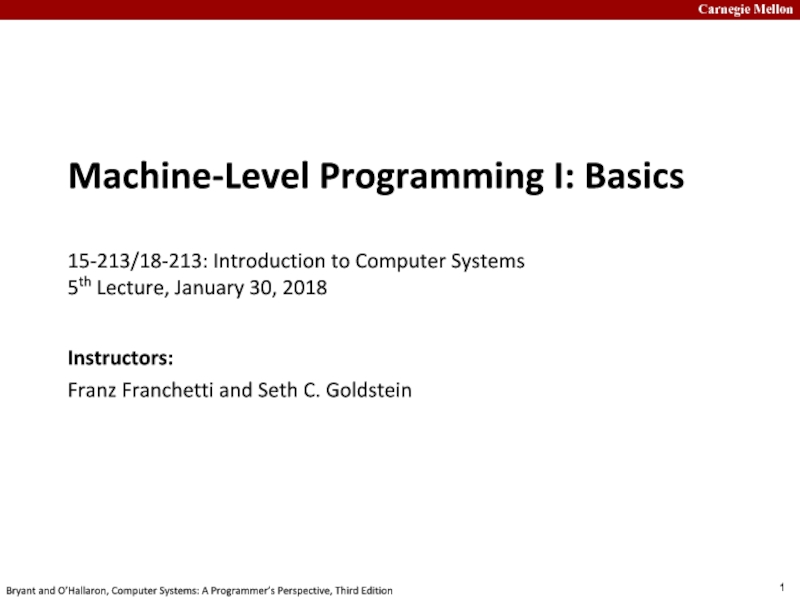

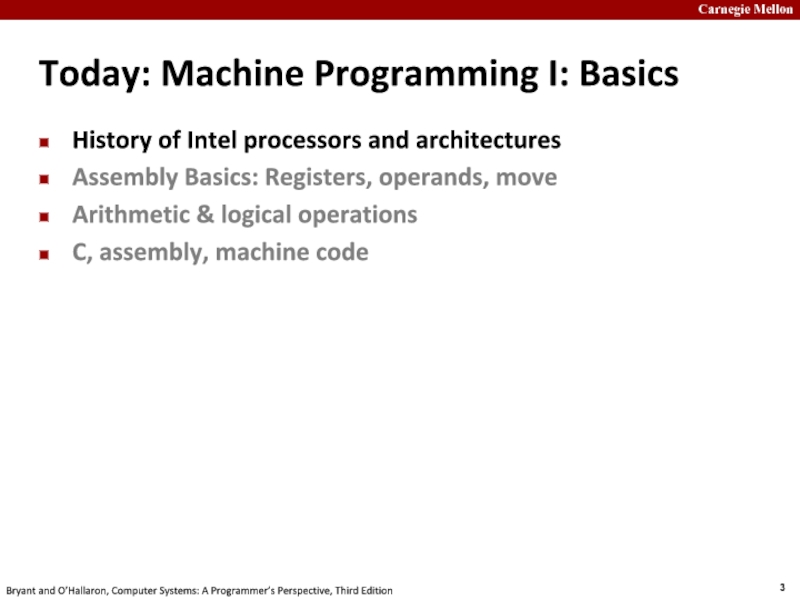

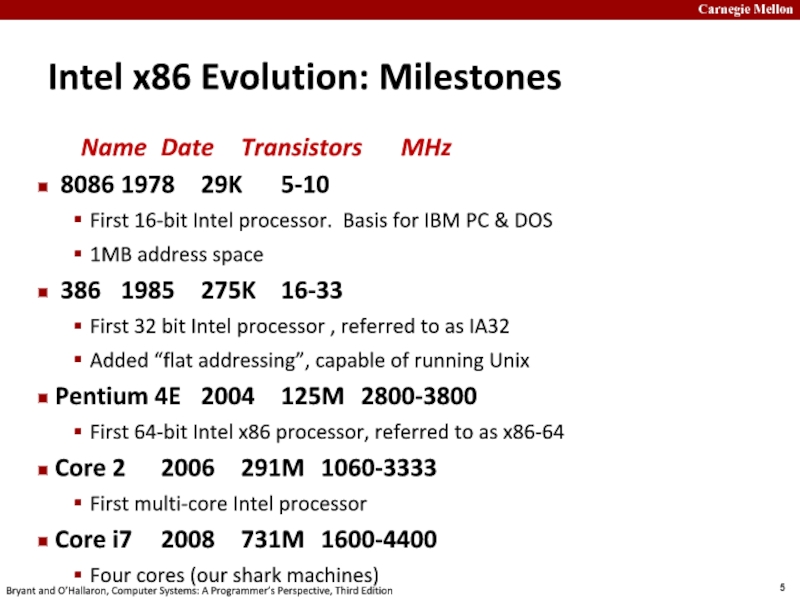
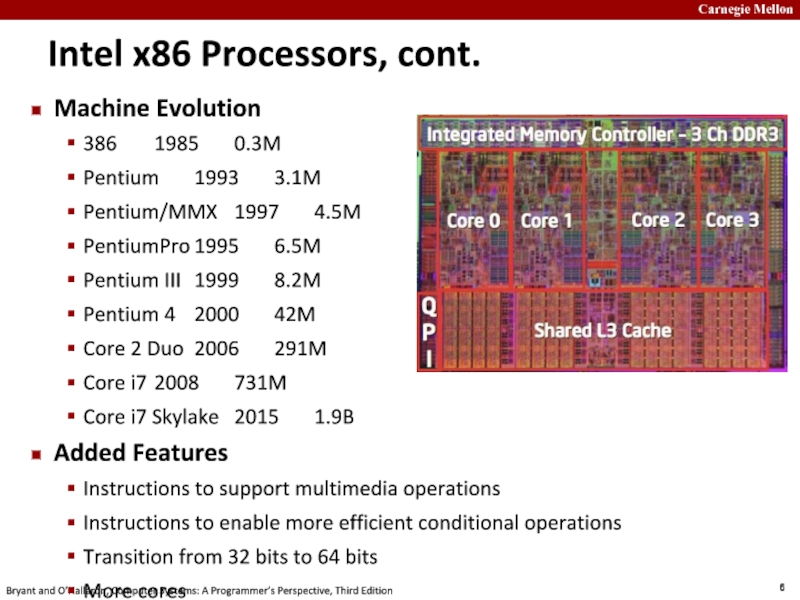
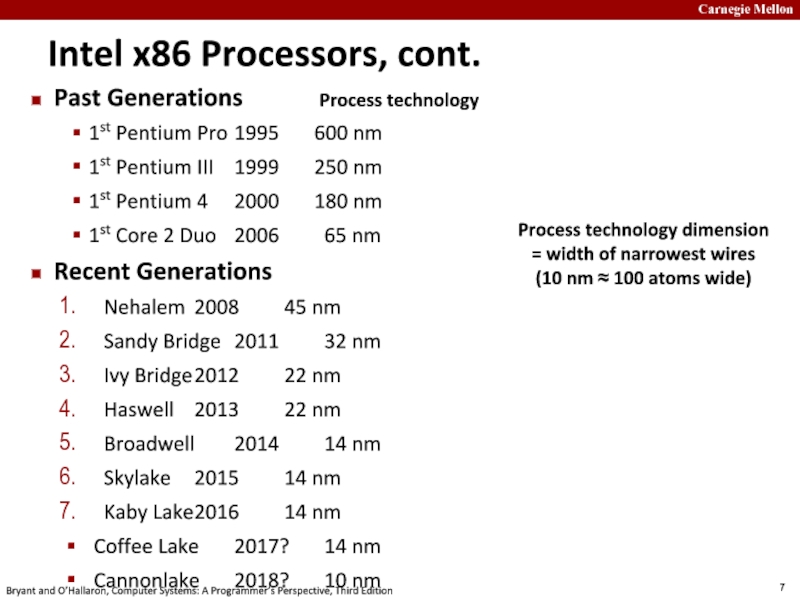
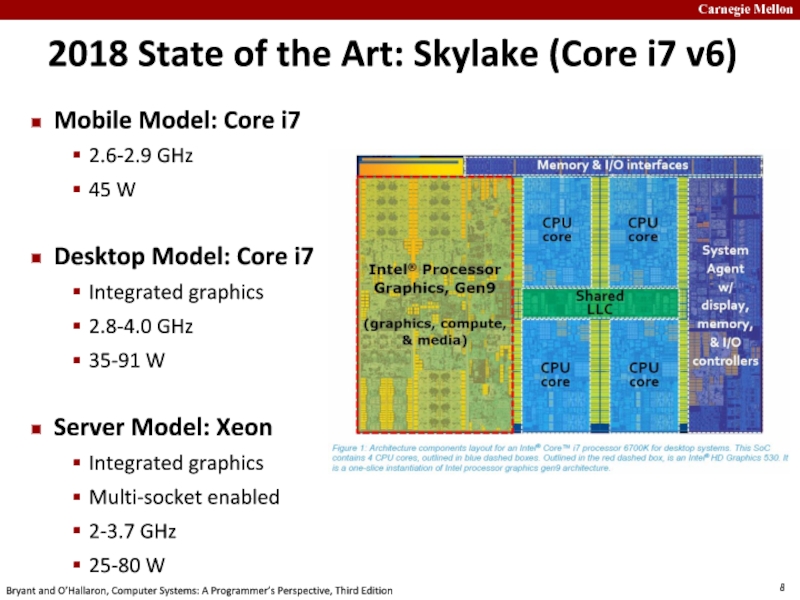
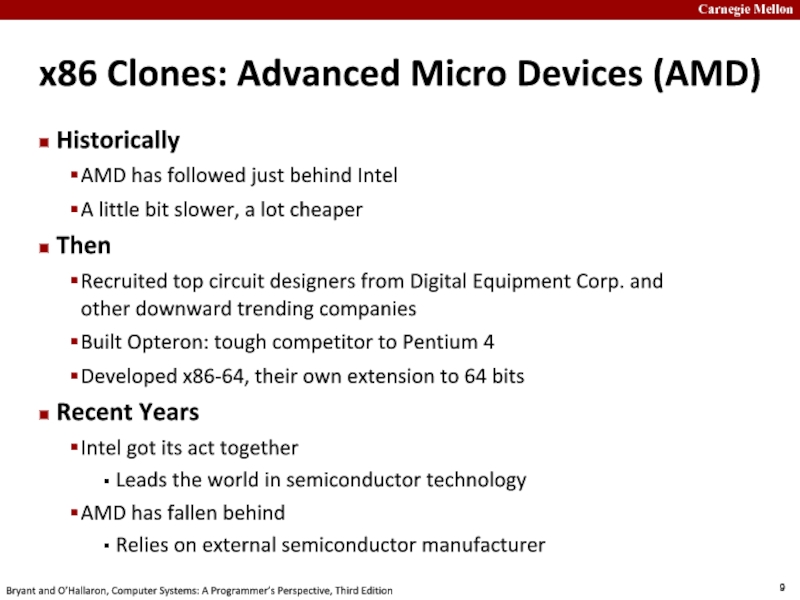
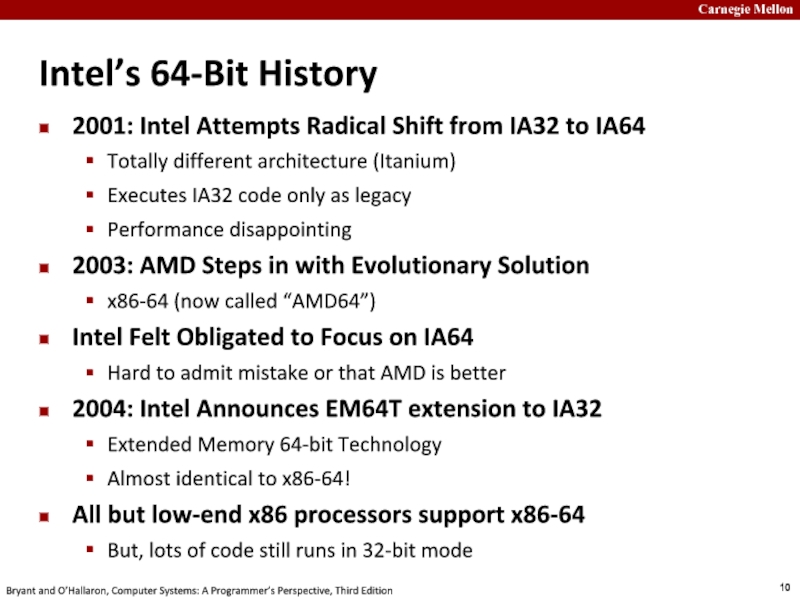
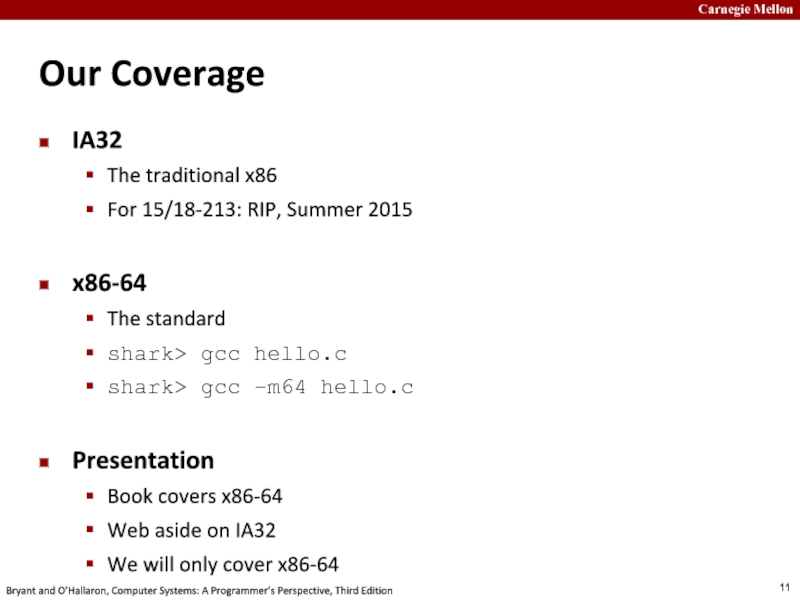
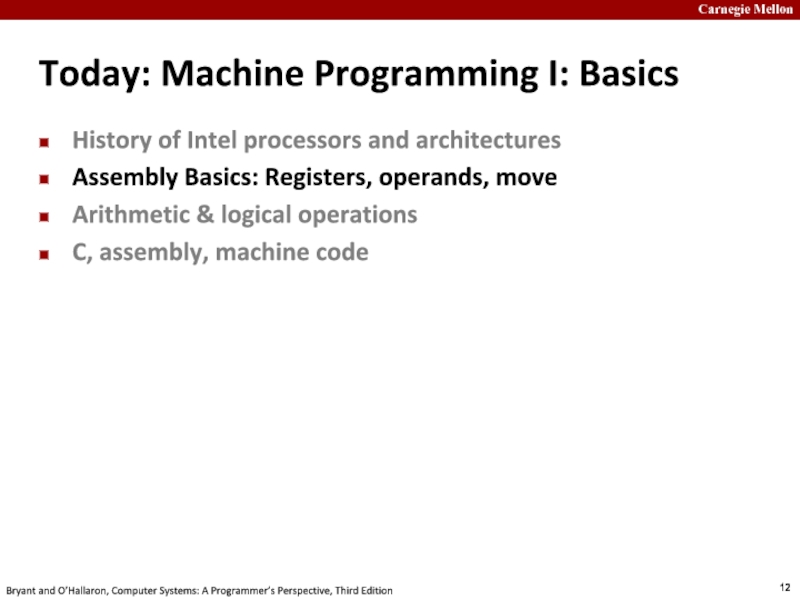
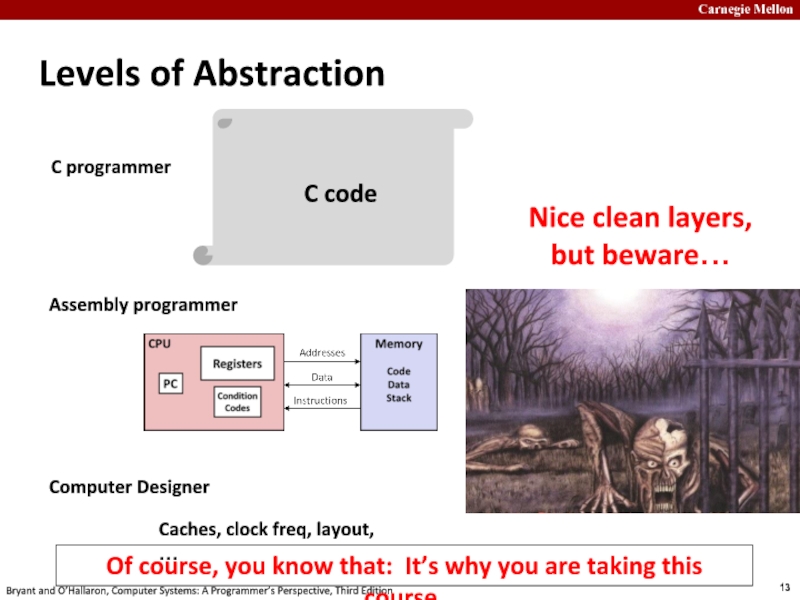
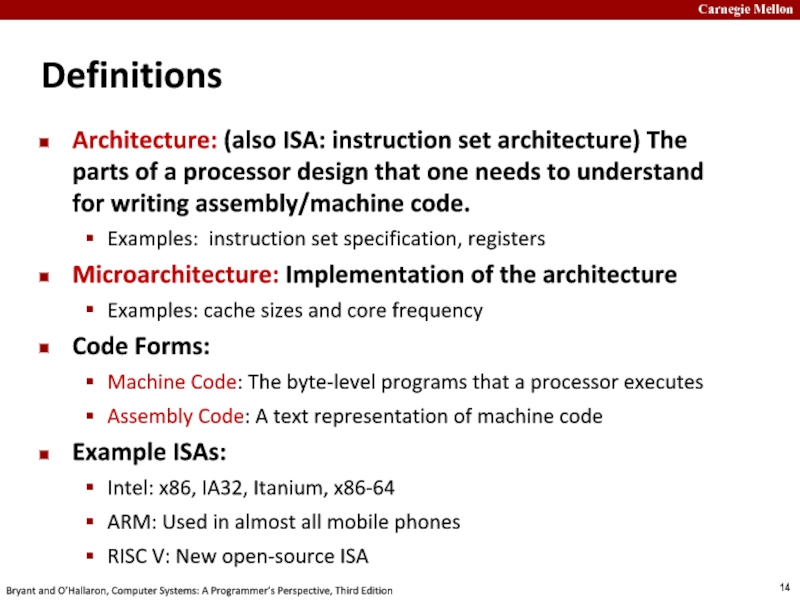
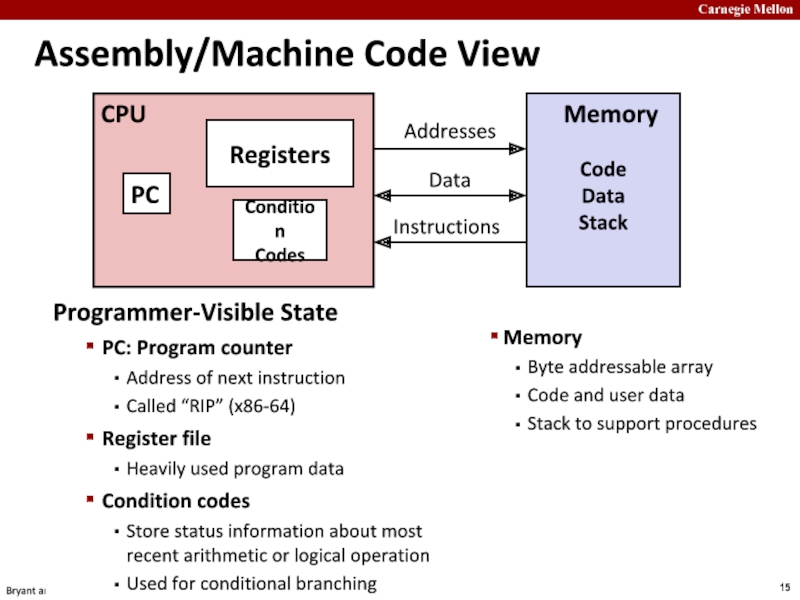
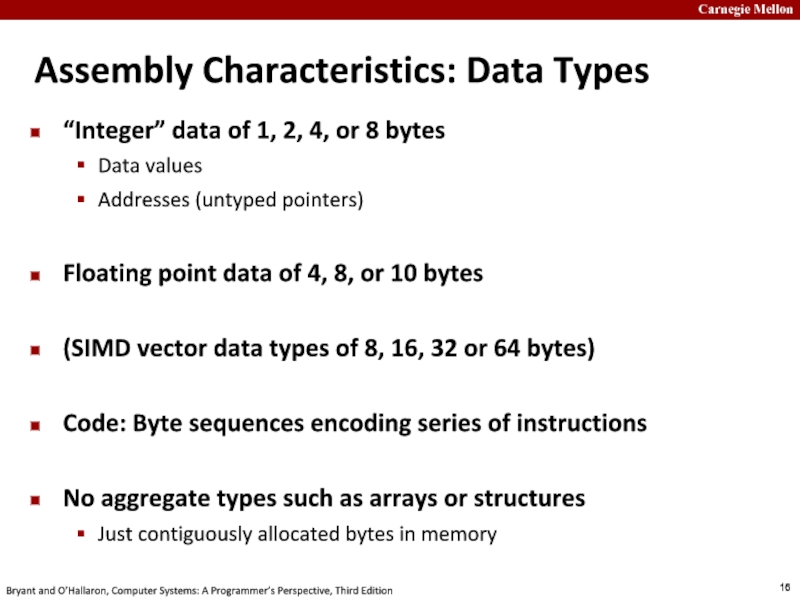
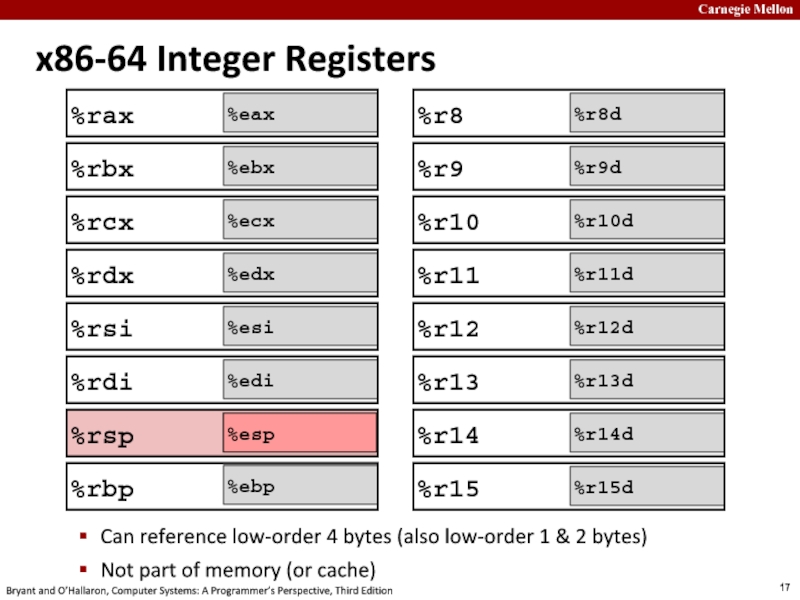
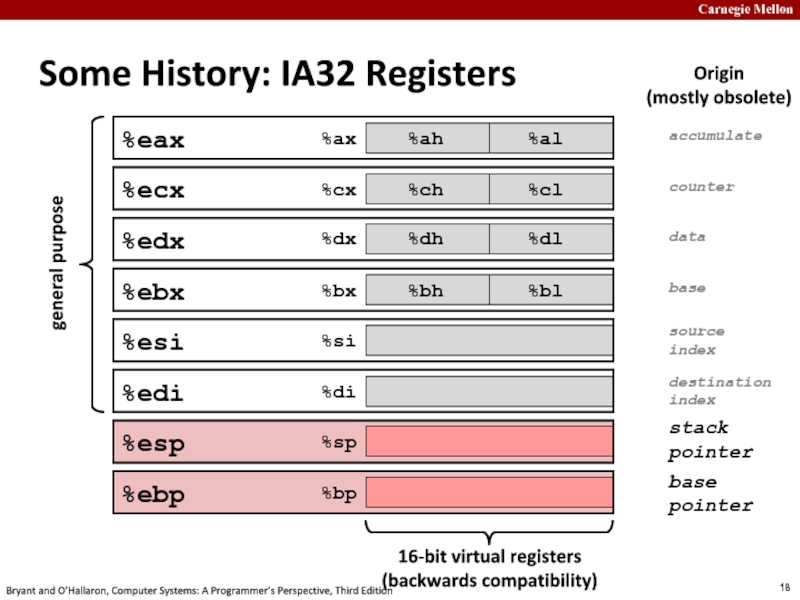
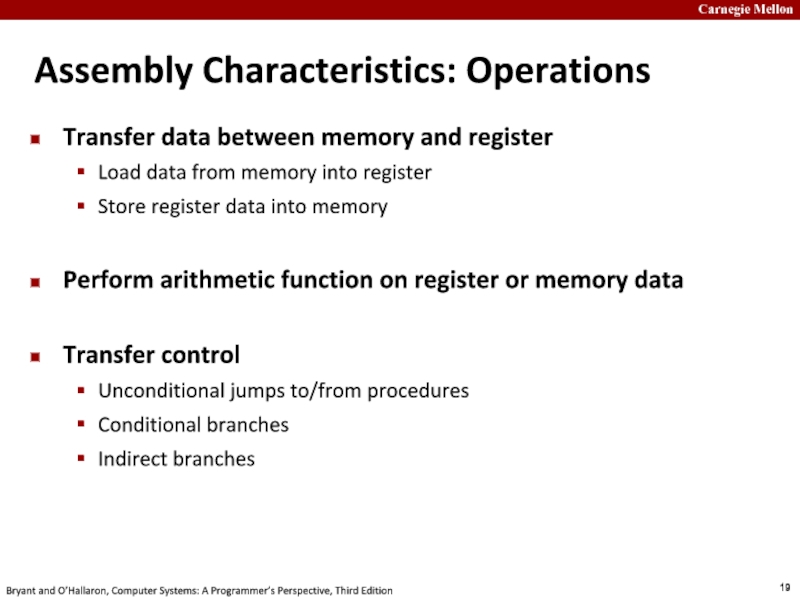
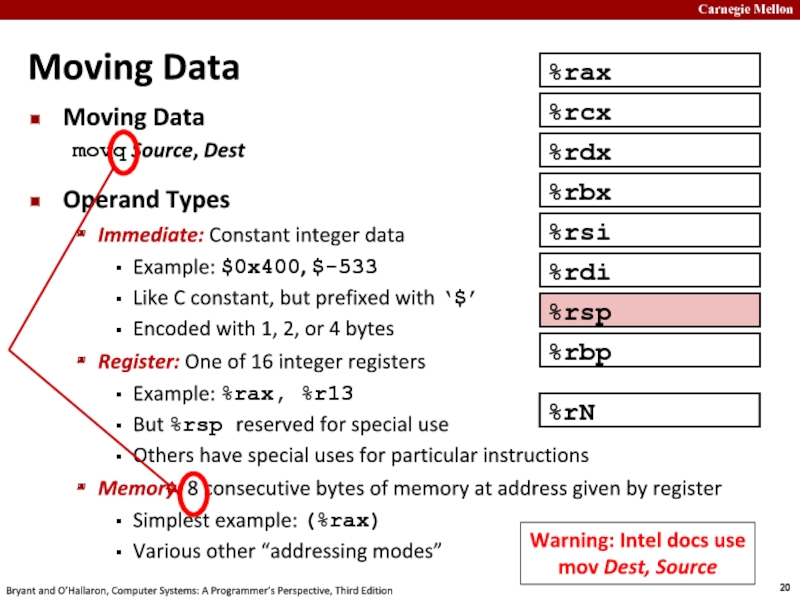
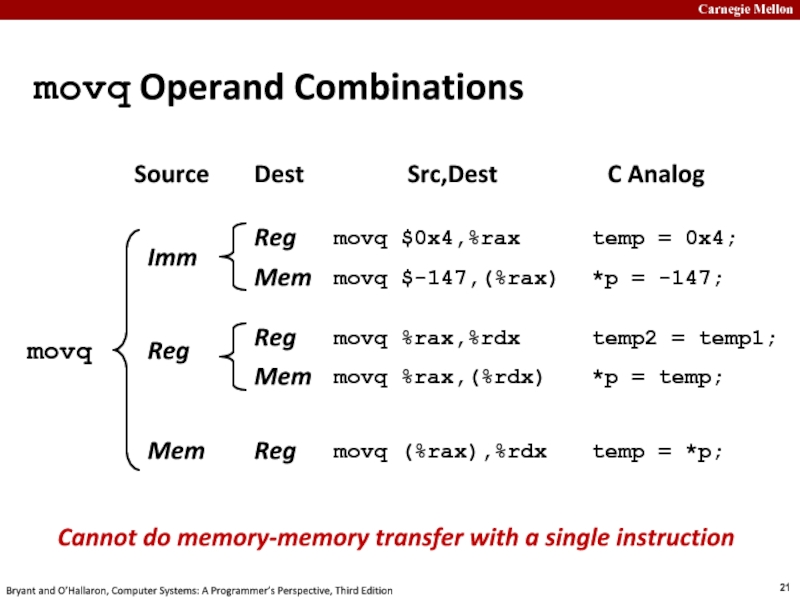
![Machine-Level Programming I: Basics 15-213/18-213 : Introduction to Computer Simple Memory Addressing ModesNormal (R) Mem[Reg[R]]Register R specifies memory addressAha! Pointer dereferencing in Simple Memory Addressing ModesNormal (R) Mem[Reg[R]]Register R specifies memory addressAha! Pointer dereferencing in C movq (%rcx),%raxDisplacement D(R) Mem[Reg[R]+D]Register R specifies](/img/thumbs/63f1ce6c78df4613e7688ae59e1b4fbe-800x.jpg)
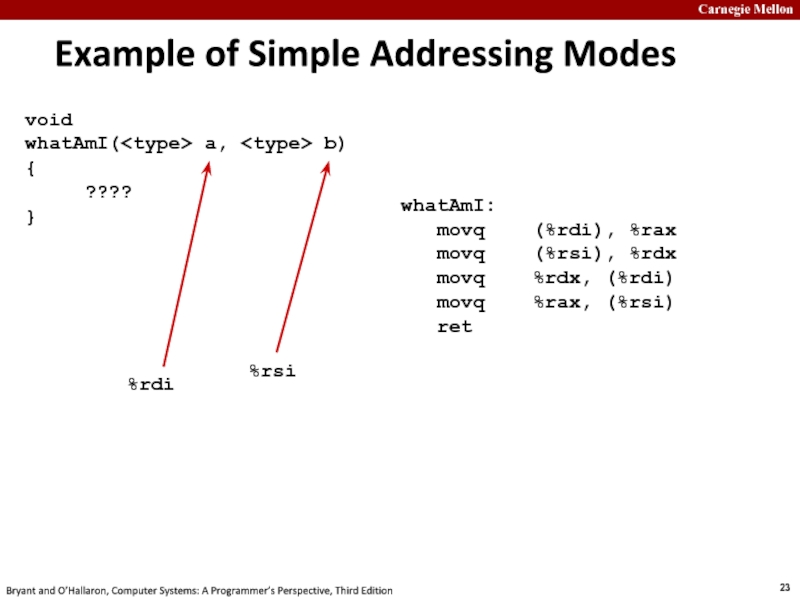
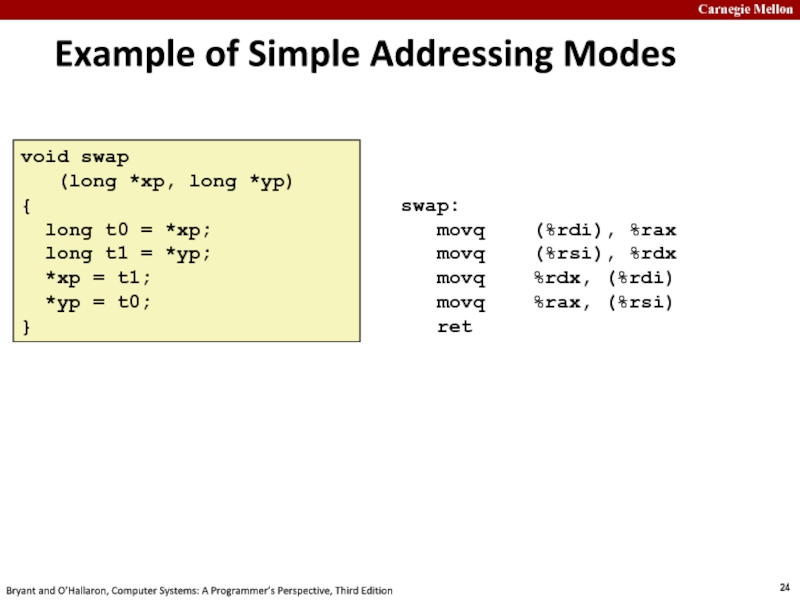
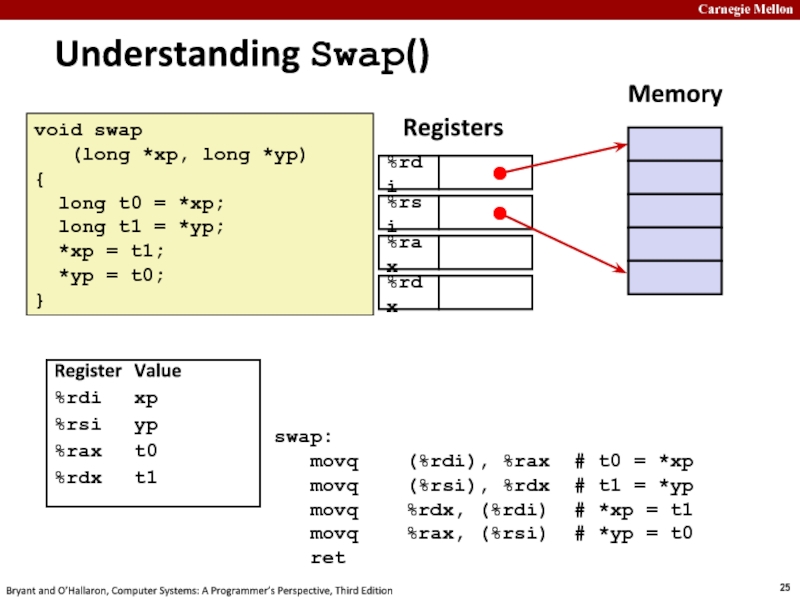
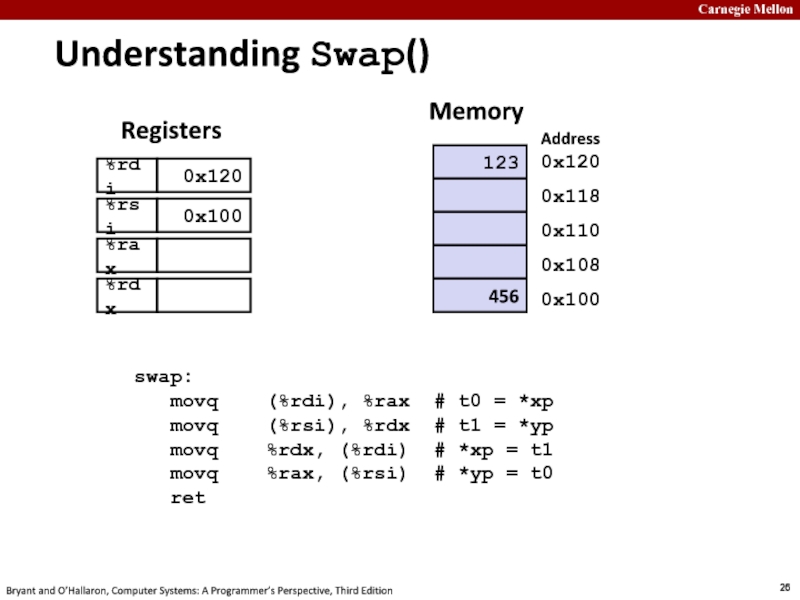
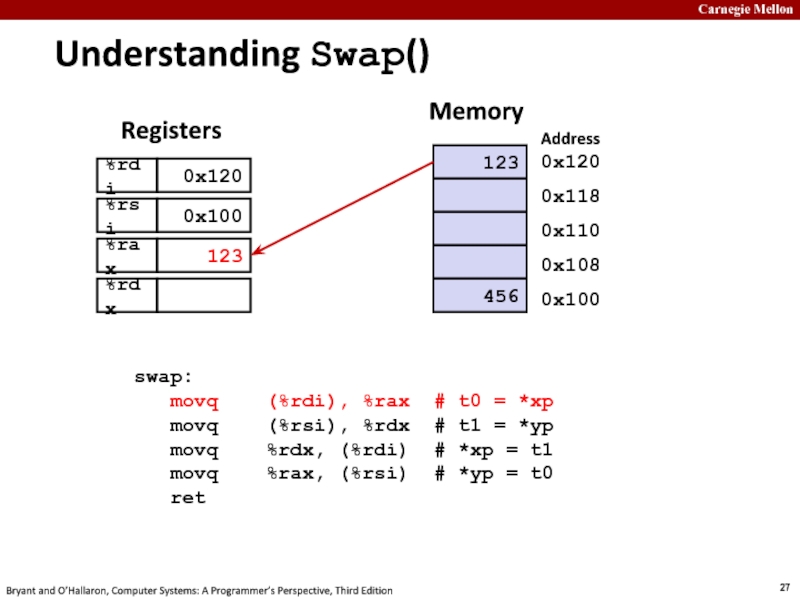
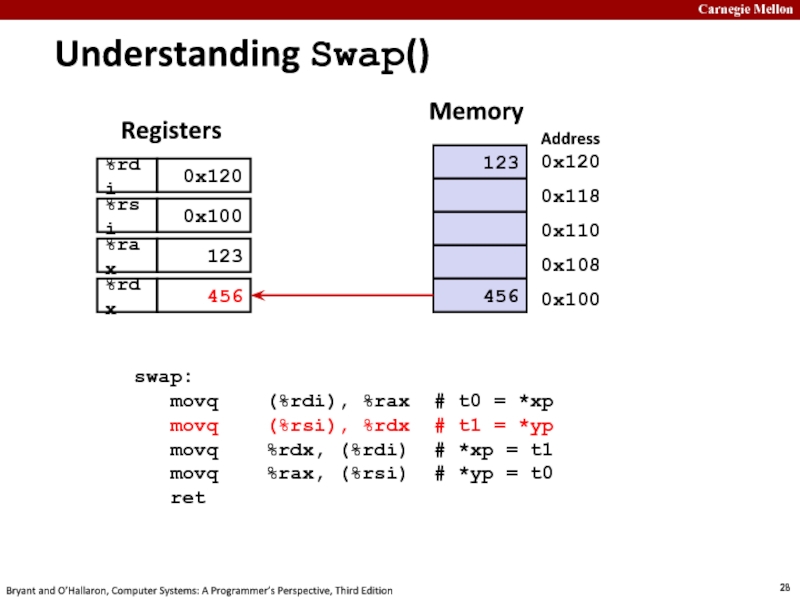
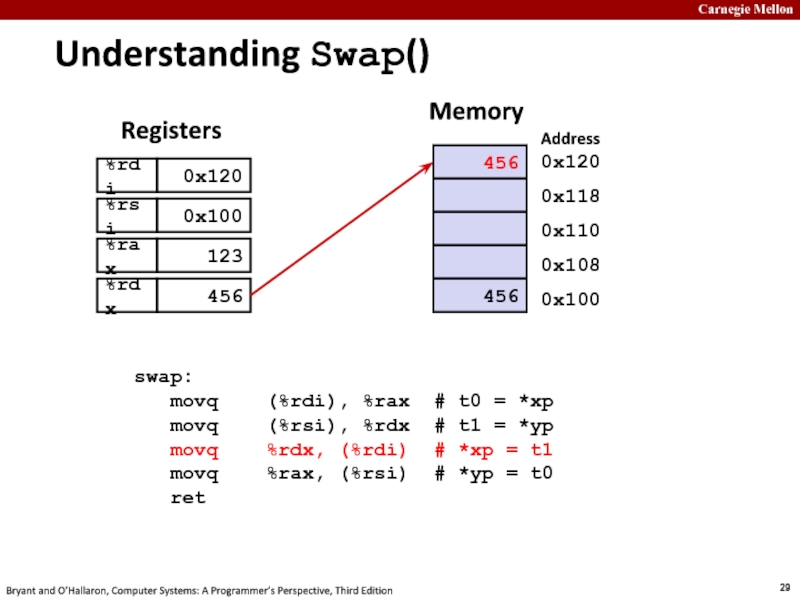
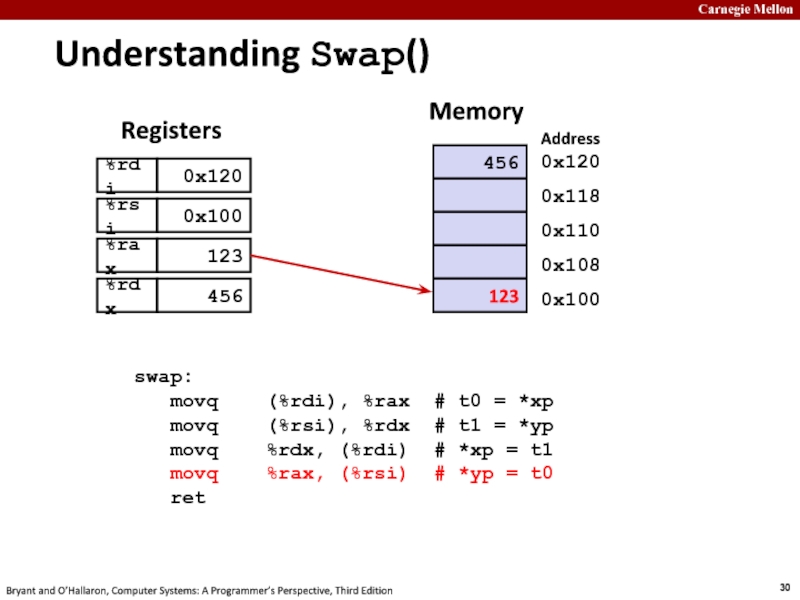
![Machine-Level Programming I: Basics 15-213/18-213 : Introduction to Computer Simple Memory Addressing ModesNormal (R) Mem[Reg[R]]Register R specifies memory addressAha! Pointer dereferencing in Simple Memory Addressing ModesNormal (R) Mem[Reg[R]]Register R specifies memory addressAha! Pointer dereferencing in C movq (%rcx),%raxDisplacement D(R) Mem[Reg[R]+D]Register R specifies](/img/tmb/3/283077/e2e4cd4a19c8b20217e090f5b931ffed-800x.jpg)
![Machine-Level Programming I: Basics 15-213/18-213 : Introduction to Computer Complete Memory Addressing ModesMost General Form D(Rb,Ri,S) Mem[Reg[Rb]+S*Reg[Ri]+ D]D: Constant “displacement” 1, 2, Complete Memory Addressing ModesMost General Form D(Rb,Ri,S) Mem[Reg[Rb]+S*Reg[Ri]+ D]D: Constant “displacement” 1, 2, or 4 bytesRb: Base register: Any](/img/tmb/3/283077/af7fb74a9f35d5ca21c46d649c854fd0-800x.jpg)
